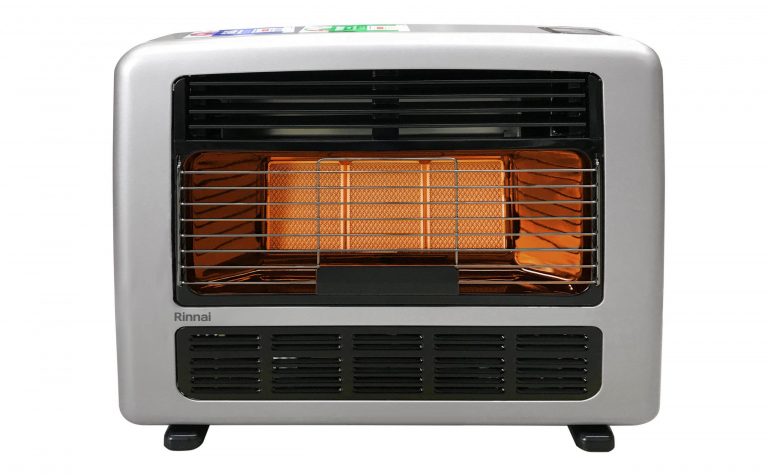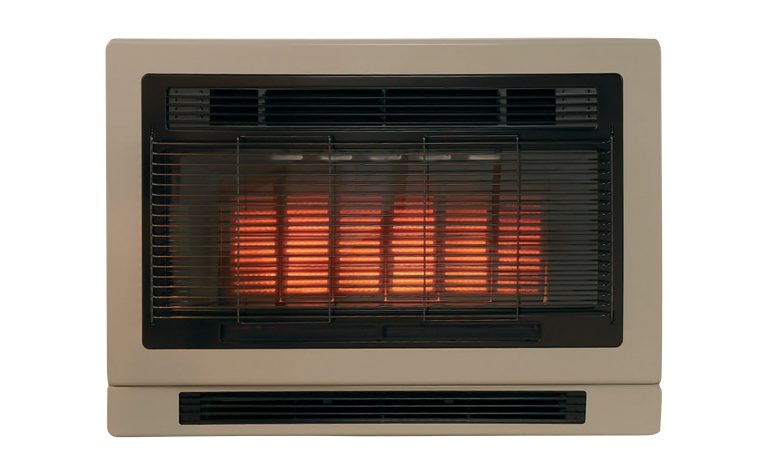Indoor Gas Heating
 Gas heating systems use natural gas, LPG (propane or butane), or biogas for heat distribution.
Gas heating systems use natural gas, LPG (propane or butane), or biogas for heat distribution.
These could be radiant or convection heaters, and either flued or unflued.
Gas heaters can be subdivided into outdoor and indoor gas heaters.
Indoor LPG heaters include unflued portable gas heaters, flued gas heaters, radiant gas heaters, convector gas heaters, radiant-convectors, and gas fireplaces.
Gas heating sub-types include radiant portable LPG heaters, convectors, radiant-convectors, flued radiant, freestanding fireplaces, fireplace inserts, inbuilt fireplace gas heaters, and power flued gas heaters.
Gas heating is an energy-efficient way to heat your home.
Its hallmarks are fast heating and on-demand warmth.
Gas heating works well in large spaces, too, so there’s no better way to provide cozy warmth to every corner of your home than with LPG gas heaters.
With a wide range of gas heating appliances to choose from, there is an LPG gas heater model that is just right for your home.
Natural Gas Heating & LPG Gas Heaters for Sale
 Depending on the model and make, a gas heater will require an LPG gas cylinder or natural gas as fuel.
Depending on the model and make, a gas heater will require an LPG gas cylinder or natural gas as fuel.
Both can provide on-demand heating and warmth to homes.
Newer gas heating systems have improved designs that are more fuel-efficient, economical, and durable than old gas heater models.
Many local appliance retailers and gas heating centres sell energy-efficient gas heaters of both types.
Common LPG Gas Heaters & Natural Gas Heating Mistakes
Finding the best LPG gas heaters and natural gas heating systems for your home means knowing the fuel type, the heating capacity you need, your budget, and other more specific factors.
Here’s a few things to think about when considering a gas heater for your home:
1. Choose a heater compatible with your home gas supply
You can choose from two types of gas heaters: natural gas heating and LPG gas heaters.
Gas heaters are manufactured for only one specific gas type and will not work safely with other type of gas.
You need to make sure you buy a gas heater model for the type of gas in your home.
Always double-check that the gas heater for sale is the right fuel type.
But why?
There are three main differences in how LPG gas heaters and natural gas heating work.
- LPG has a higher calorific value or energy content, so less gas is required to produce the same amount of heat as you would with natural gas.
- The oxygen-to-fuel ratio required for proper combustion is different.
- The incoming gas pressure is higher for an LPG heater.
LPG gas heaters require an oxygen-to-gas ratio of approximately 25 to 1, while natural gas heating requires a ratio of around 10 to 1.
To achieve this difference, the heaters can be provided with different size gas jets and burners.
LPG is typically provided in a smaller quantity but at a higher pressure, drawing more oxygen into the burner.
2. If your gas heater is not compatible with your home fuel – convert it or buy a new appliance
Never attempt to connect a gas appliance to the wrong type of gas, as it can be extremely hazardous.
If you have a natural gas heater but your home gas runs on LPG, or vica versa, then you will need to either have a licensed professional convert your gas heater to run on a different fuel, or you need to buy a new gas heater that is compatible with your home gas supply.
Modifying gas heaters is always a job for a professional.
Conversion is not always possible, based on the age and model of gas heater you have, as the manufacturer may not offer conversion kits for older models.
3. Use the correct gas heater size for your space
 Gas heaters come with in various sizes with different heat outputs.
Gas heaters come with in various sizes with different heat outputs.
If you buy a gas heater that’s too small for your home area, it will not be able to adequately heat the intended area.
Buying a gas heater that is too large, on the other hand, will cost you extra money, and oversizing can be unsafe.
Like Goldilocks, you want the one that is just right.
You can use the table below as a rough guide, or speak to your LPG gas heater store representative to determine which size is best for your home or specific use.
Gas Heater Sizing Guide
| Room Size | kW Heat Output | Gas Consumption |
| Small (29–42sqm) | 2.9–4.2kW | 13–15MJ/h |
| Medium (46–66sqm) | 3.4–6.6kW | 18–21MJ/h |
| Large (52–82sqm) | 5.2–8.2kW | 23+MJ/h |
These are generalised recommendations. You should consult the manufacturers’ sizing guides to make a final decision.
4. Check the specifications before you buy
When buying a gas heater you need to make sure it is the right fuel type, is the right size for your space, and has a good star rating for energy efficiency.
Compare options and make sure you get the best choice for your home, in that it will not only heat the area intended but also do it cost efficiently.
What Size Natural Gas or LPG Gas Heater Do I Need?
Finding the right LPG/LNG gas heater size for your needs will help keep your room warm without breaking the bank or hurting your energy bill.
What to Consider with Gas Heating
A number of things need to be considered when determining your heater sizing:
- The volume of the area to be heated, including the ceiling height.
- The climate zone that you live in. Whether you’re in a warmer NZ region or one of those experiencing frigid cold winters.
- The physical features of your home, include wall & ceiling insulation, window coverings, and carpeting.
- The kW heat output of the gas heater. Not to be confused with the MJ gas input.
Heating Area Volume & Climate Zone
 The required kW output primarily depends upon the area to be heated and the climate zone in which you live. You want the best LPG gas heater with the right heating capacity (kW) that
The required kW output primarily depends upon the area to be heated and the climate zone in which you live. You want the best LPG gas heater with the right heating capacity (kW) that
meets the required heat output. The following rough guide assumes your ceilings are no higher than 2.4M:
- Very Cold Zone: 1kW output required for each 8.5m²
- Cold Zone: 1 kW output required for each 10m²
- Cool Zone: 1kW output required for each 13 m²
- Mild Zone: 1kW output required for each 16m²
Gas Heating Adjustment Factors
The indicated heating areas would be adjusted down by 5% for each of the following conditions: houses built on pillars (non-slab), no carpets on floors, no drapes on windows, or a ceiling height exceeding 2.4m.
This must also be factored in when selecting the best gas heater for sale that meets this adjusted heat output.
Deduct an additional 10% if the area does not have ceiling insulation.
Please note that this is only a guide, and individual home designs and situations may vary.
Gas Heater Sizing Example #1:
You live in the Cold Zone and want to heat an area 5m X 10m, which equals 50m². Because 1kW will heat 10m², you should need a heater with a 5kW output.
Gas Heater Sizing Example #2:
Same as the previous example, but in this case, your ceilings are over 2.4m, and you have wood flooring instead of carpeting.
You would need to deduct 5% for each of these two items.
So, instead of 1 kW heating 10m², it would heat 9m² (10% total reduction).
This means you would need a heater with 5.6 kW of output (50 ÷ 9).
Use kW, not MJ, for Natural Gas or LPG Gas Heater
 Megajoules per Hour (MJ/hr) ratings on appliances indicate the appliance’s gas consumption, not the heat output.
Megajoules per Hour (MJ/hr) ratings on appliances indicate the appliance’s gas consumption, not the heat output.
Many LPG gas heaters for sale are advertised using MJ ratings.
You need to ask our LPG technicians about the kW heat output rating, which is often expressed as just MJ. Kilowatt-hour (kWh or just kW) measures gas heater output.
Look at the specifications on the box, the manufacturer’s website or in the Owners Manual.
Energy Efficiency Matters: Star Ratings for Natural & LPG Gas Heater
 Remember to use both kW and MJ when comparing.
Remember to use both kW and MJ when comparing.
The efficiency of the gas heater for sale, in converting gas energy to heat, is a key factor.
For example, a 25MJ LPG gas heater for sale with a 5.8 Star rating has an output of 6.2kW.
A 25MJ heater with a 2.8 Star rating only has an output of 5.0kW.
As a result, in a Cold Zone climate, they would heat 62m² and 50m², respectively.
This means that the 5.8 Star heater will heat an area 24% larger while using the same amount of gas.
Please refer to the manufacturers’ specifications to determine the exact kW output and MJ input for each heater you are considering.
Star Ratings and Thermal Efficiency Chart
| Star Ratings | 1 | 1.5 | 2 | 2.5 | 3 | 3.5 | 4 | 4.5 | 5 | 5.5 | 6 |
| Thermal Efficiency | 61% | 64% | 67% | 70% | 73% | 76% | 79% | 82% | 85% | 88% | 91% |
Minimum Room Sizing
Portable gas heaters for sale should not be used in bedrooms, bathrooms, or hallways.
The government may specify the minimum room size (volume of room in M³) and minimum ventilation requirements for unflued heaters.
Minimum room size also varies between thermostatically controlled and manually controlled heaters.
All installations must comply with Australian/NZ Standard AS5601 – Gas Installations. Your gas fitter can guide you on many of these points.
Manufacturer Sizing Charts for Natural Gas or LPG Gas Heaters
To make it even easier, some manufacturers have sizing charts for their heaters, based on climate zone maps.
Measure the area you wish to heat and use these charts and maps to buy the correctly sized LPG gas heater for sale.
It is always wise to follow the manufacturer’s advice.